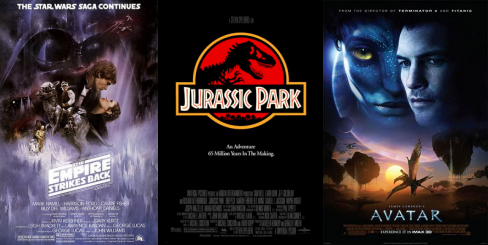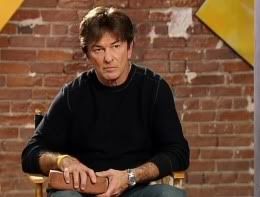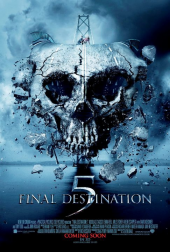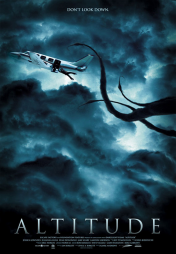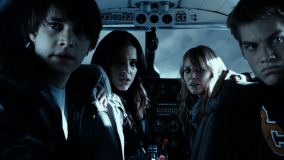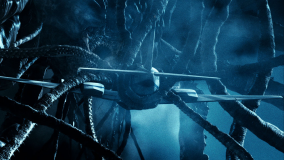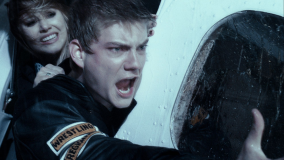
by XdarksparkX
Originally written for COM311 - "The Early History Of Film":
November 20, 2011
Usually when a director makes the specific choice to sign on to remake a film that already exists, it’s often because he or she has a message that can be retold in a similar package. The current climate of the Hollywood machine grants them much better odds of getting said message out through a remake rather than an entirely original film. According to Hollywood, originality doesn’t sell like a film that explicitly channels the title and specific plot of a previously established story.
That being said, I still cannot fathom why I have to preface the term “Psycho” with “The Original” in a grumbling, almost venomous tone when referencing it within the context of cinematic history. In this world, perfection is a simple illusion of the human mind when it is attributed to a medium that does not have a set number of feats attainable. For instance, you can be “perfect” in Guitar Hero, because there are a finite and specific number of notes per song. However it is metaphysically impossible to find honest, definition-bound perfection within the context of a property that exists with infinite possibilities, such as in film, music or life. With that said, Hitchcock’s 1960 classic Psycho grazed the most attainable tips of perfection when it came to putting Robert Bloch’s novel onto a visual medium. The way that Hitchcock presented the story worked in every single way. One could argue that you cannot truly “improve” upon it because everything was done with not only a deep, thoughtful, and calculated precision, but because the artistic flares that one would consider things to “fix” are what make the experience so memorable.
So then why in the Hell of H.P. Lovecraft did a remake find its way into theaters in the winter chill of December, 1998? Sure, if Universal was just that adamant about remaking Psycho, then who could blame Gus Van Sant for jumping at the chance? That’s not my gripe -- my gripe is the fact that he was afforded the opportunity to take a revered classic that was being remade for the pure profit potential and not screw it up, only to be blatantly afraid of screwing it up and ironically screw it up by doing nothing with it and taking the dense way out. Van Sant got away with simply looking at Hitchcock’s masterpiece, saying “this is how he did it, so that’s how we’ll do it” and calling it a day. The saying that you can’t improve upon perfection (or in this case, near-perfection I suppose) still holds true, however how much of an oblivious moron do you have to be to willing put yourself up for comparison against near-perfection by attempting to do a shot-for-shot mimeograph of the original? You might as well bring a knife to a gun fight and become surprised when you find a bullet lodged in your face.
It seems like Van Sant didn’t even try to think about the small idiosyncrasies as to why Hitchcock did what he did. For example, a lot of Hitchcock’s Hollywood films were in Technicolor, so many of them that one could say Hitch was enamored with the process. So why is it then that he chose to do Psycho in black-and-white? Personally, I feel it’s because of the ironic nature of having a film with limited spectral range that aligns with the common perceptions of Good and Evil, while the characters within the film are so morally ambiguous. Marion isn’t exactly a bad person, but she isn’t a saint either. We come to find out that Norman is just flat out insane, so while convenient as it may be to label him ‘evil’, that’s not exactly accurate. The black-and-white coloring choice shows us just what we need to see, while at the same time commentating on the fact that what we’re seeing is simply the contrasts in between light and dark; everything that lies within is simply the tinted white and the deepest gray.
The killer in the wig about this to me is that both films were based on the novel. So rather than isolate himself from the Hitchcock film, read the novel, and come up with his own interpretations of the events (updated to a late-90s setting), Van Sant chose to create a blatant reflection of the original film. Make your film stand on its own, Gus. Experiment with other camera angles, tinker with different lighting setups for certain scenes. Get freaking creative, for crying out loud. Borrow bits and pieces that you just felt Hitchcock did so masterfully that they deserve to be rehashed, but not the entire 105 minutes of the freaking film.
This is without even getting into the characters. The fact that casting director Howard Feuer actually got a legitimate check for presenting Vince Vaughn’s headshot to Van Sant absolutely boggles my mind. Now, I’m not one of those people who feels that actors should be locked away in their genre of preference and have the key violently thrown away, however Vaughn had to have been near the top of the list for “Worst Potential Selections To Play Norman Bates”, and someone simply mislabeled the lists and handed Gus the wrong one. I refuse to believe that his casting was intentional lest it was the last resort when all other potentials declined. With Anthony Perkins, he brought an amazingly believable innocence to Norman. He felt like someone who was isolated, but not someone who was completely bat-shit insane. To this day, when I watch the original I still have to remind myself that he is the guy who acts as if his dead mother is still alive in order to fulfill the most warped and deranged sense of a moral compass. The second Vince Vaughn steps on screen, an air of unease follows in his wake and permeates the audience. His stiff, awkward delivery doesn’t help calm the fact that the “warning” lights in our brains are going off like Robot from Lost In Space just sensed that the Velociraptors have escaped from their containment area in Jurassic Park, and is proceeding to cycle his infamous “Danger! Danger, Will Robinson!” sound bite as the perimeter fence alarms blare all over Isla Nublar. His awkward, forced chuckles lack any sort of intended adolescent introversion and instead violently scream “guy with a dark secret and something horrible to hide”.
Anne Heche I don’t have as much of a problem with, mainly because Marion Crane is arguably what Hitch would call a “MacGuffin” -- a plot device that exists for the sole purpose of moving the story where it needs to go -- so that the story can reach it’s true central character: Norman Bates. However, in the sparse time she was on-screen there was one time where a display of cringe-worthy “acting” came into play. During the scenes where Marion is driving away from Phoenix, I was always under the guise that the conversations we heard weren’t just those that were actually happening, but ones that she herself was playing out in her head. However, while these conversations go on, Heche gives us little more than a wide-eyed “deer in the headlights” look as the conversations further incriminating her play in her head. There’s no nervousness, or tension that we see from her expressions, she simply stares off into the camera like she’s about to have an eye exam. I don’t recall Janet Leigh doing much with this either, but you could at least feel the apprehension from the character knowing that what she’s doing wasn’t right.
I think the principle problem with Marion’s character is that we don’t care about her, and Van Sant did nothing in an attempt to change this. Even if in the original she was a very bland and simple MacGuffin, at least with the remake attempt to veil this and make her an interesting MacGuffin. It’s only after she dies that we sit back and realize that we didn’t care about her at all; the horror we feel is that of pure shock that we supposedly just witnessed an overprotective mother commit murder because her son simply talked to this woman. We never knew Marion’s true motivations for laundering the money, or where she’s even going with said money. No exposition, nothing. So why not take your remake and attempt to get the audience to connect at least a little with Marion, Gus? Why not attempt to get us to the point that when she’s murdered, we at least feel something as opposed to nothing?
Now, whether or not the blame for these performances -- primarily Vince Vaughn’s -- and their lack of actual emotional depth falls on the actors or Van Sant is questionable. If those of us who haven’t committed ourselves after viewing them remember correctly, the Star Wars prequel films were able to claim Natalie Portman as Padme, the primary female protagonist and eventual mother of Luke and Leia. The same Natalie Portman that came off awkward and stiff in those films is the same one who was absolutely mesmerizing and won an Oscar for her performance as the lead in Black Swan. Given the fact that -- through his track record -- we already know Lucas couldn’t properly direct actors even if his precious morning coffee and comfy chair in front of the monitors were in jeopardy, we can safely blame that bit of performance farce on him. However, who do we blame this particular farce on? Honestly, I want to blame both. In Vaughn’s case, he clearly had very little in the way of an actual grasp on the character and his basic psychology, and therefore turned in a completely non-committal performance. He toes the line of everything we already know of Norman and what we will come to know of him, and it ends up feeling completely… wrong. Perkins committed to exactly what was required to know about Norman at that point in the film, which in turn made the final twist all the more shocking. He was awkward due to years lacking actual human connection, and was strongly protective of his mother as she was the only thing he ever had; it was much easier to accept that Vaughn turned out to be Norma that it was to accept that it was Perkins, because Vaughn let off a constant vibe of someone that hid a dark secret. Van Sant on the other hand gets the blame only because within every other facet of the movie he was so desperate to mimic Hitchcock that he forgot to add creativity, and this could’ve very well been one of those moments where he simply pointed to the original performances as reference material and called it a day.
I think that the glaring difference between the films is simply a lack of vision, creative spark, or motivation to make a decent film when it comes to the Van Sant version. There was a glaring lack of focus that resonates throughout the entire film. They changed the year the film takes place to 1998, and while they change the monetary values to reflect this, everything else in the film has the distinct impression that it was pulled right from the worn pages of a 1950s Sears catalog. There’s a mention of a Vinyl Records store, why? Vinyl was all but dead by 1998 -- Hell, freaking cassette tapes were clinging to life support at that point. Why not say that Marion’s sister worked at The Wall or something? I don’t know if that’s the right answer to the problem, but just something that resonated closer with the 1998 music scene than freaking vinyl records. Marion’s boss says something along the lines of “A cash transaction of this size -- highly unusual”. Who spoke that way in 1998? It’s amazing to me that the filmmakers claim that they had an actual focus on “updating” the film in the DVD commentary and yet completely missed so many glaring references to a different period. I’m not going to even go into the astonishment I have for the fact that for all the things the 1998 version blatantly copied from the original, they specifically chose not to use the original Psycho house that is currently located on the Universal Studios Hollywood backlot. Oh, was that just a bit too much blatant plagiarism for you, Gus? You ripped off everything else, including a majority of your shots, you might as well have taken the house down in the Titanic with you! Ugh, where the hell did I put the Advil?
In the films, Norman Bates says “We just keep lighting the lights and following formalities”, and in an almost philosophical irony, that is exactly what the remake came out to be -- nothing more than a pathetic, expensive, blasé exercise in filmmaking in which the director had no deep creative spark or passion for what he was putting forth onto the celluloid. The 1998 Psycho should be the textbook example of everything you shouldn’t do when it comes to the art of filmmaking. Have a vision that you can call your own. Have infectious passion for what you’re doing. Embrace outrageous creative ideas. Take chances and make mistakes in the wake of that creativity. Just f’n give a damn.

